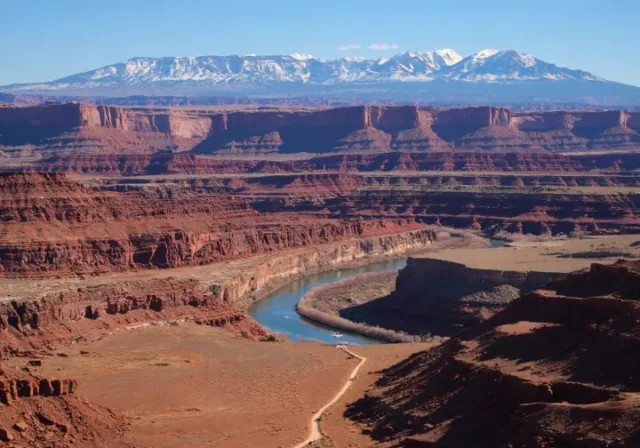In this article
Many adventurers are drawn to Moab, Utah, by the iconic images of Delicate Arch. While Arches National Park is undoubtedly spectacular, the Moab region offers a much deeper wellspring of adventure. We know the call of the red rock desert and the Colorado River, and there are countless things to do at moab utah that often get overlooked. This journey explores the vastness of Canyonlands, the breathtaking views from Dead Horse Point, world-class mountain biking trails, exhilarating river rafting, thrilling off-roading, scenic hiking outside the parks, and unique local history – many great things to do.
Ready to see what lies beyond the familiar archways? We’ll guide you through the diverse currents of activities that make Moab, Utah, a truly unforgettable destination. Let’s explore the other amazing things this corner of Utah holds.
Explore Canyonlands Vastness
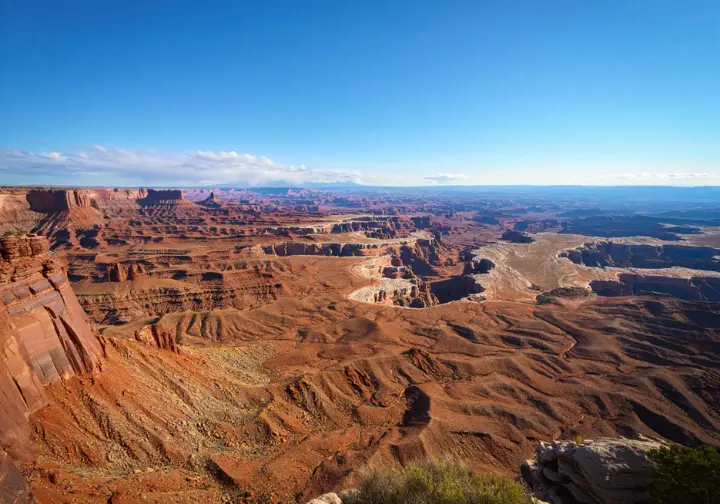
Just a stone’s throw from the bustling Arches entrance lies Canyonlands National Park, a sprawling wilderness carved by the Colorado and Green Rivers. This immense land offers distinct districts, each promising unique adventures and often, a welcome dose of solitude far from the crowds. It’s a core part of the moab utah what to do experience.
Hike Island in the Sky
The Island in the Sky district is Canyonlands’ most accessible mesa-top perch. It offers easily reachable, stunning panoramic viewpoints, making it ideal for shorter visits or those seeking less strenuous paths. Driving the 34-mile scenic byway here involves stopping at overlooks like Grand View Point for sweeping vistas that rival any canyon view. Have you ever felt like you were standing on the edge of the world?
Engage in relatively easy mesa-top hiking to iconic formations. The famous Mesa Arch, a photographer’s dream at sunrise, requires only a short 0.7-mile loop trail. Be mindful, its popularity means arriving early is wise – a common oversight we see is underestimating the sunrise crowd. Other accessible trails include the White Rim Overlook Trail (1.8 miles) and paths to Aztec Butte or Whale Rock, offering diverse perspectives without extreme difficulty.
Before you go, understand the logistics. Canyonlands requires a park entrance fee ($30/vehicle as of research date, passes accepted). The Island in the Sky Visitor Center provides essential information, water, and exhibits. For overnight stays, the Willow Flat Campground has limited first-come, first-served sites with no water, demanding self-sufficiency.
For the more intrepid, longer, strenuous trails descend from the mesa rim. Routes like the Gooseberry Trail or Syncline Loop offer a more immersive backcountry experience but demand significant preparation and fitness. These paths showcase the dramatic elevation changes and lead towards the White Rim layer, a different kind of Moab canyon challenge. Planning to drive or bike the famous 100-mile White Rim Road? Secure day-use or overnight permits months in advance via Recreation.gov; they are highly competitive.
Discover Needles District
Venture southeast of Moab to the Needles District for a different flavor of Canyonlands exploration. This area focuses on immersive hiking amidst colorful Cedar Mesa Sandstone spires and extensive trail networks. The drive is longer than to Island in the Sky, but the reward is unique geology and a deeper sense of wilderness.
Explore diverse hiking trails here. Options range from short interpretive loops like the Cave Spring Trail (0.6 miles), featuring a historic cowboy camp, rock art, and ladders, to challenging backpacking routes like the classic Chesler Park Loop. With roughly 74 miles of trails, there’s a path for nearly every fitness level, leading to features like Druid Arch or offering expansive scenic views on the Slickrock Trail (distinct from the famous bike trail).
Accessing certain areas requires planning. Challenging 4WD roads like Elephant Hill need high-clearance vehicles and specific day-use permits. All overnight backpacking trips also require permits secured well in advance. A common mistake is assuming easy access; preparation is key for these rugged routes. What kind of trail challenge are you seeking?
Camping arrangements need care. The Needles Campground offers limited individual sites ($20/night as of research date), some reservable seasonally, plus group sites. Drinking water is seasonal at the campground; backcountry hikers must carry or treat all water. The Needles Outpost near the entrance offers supplies and more camping. Appreciate the cultural depth by seeking prehistoric rock art, visible on the Cave Spring Trail and in the separate Horseshoe Canyon unit.
Visit Dead Horse Point
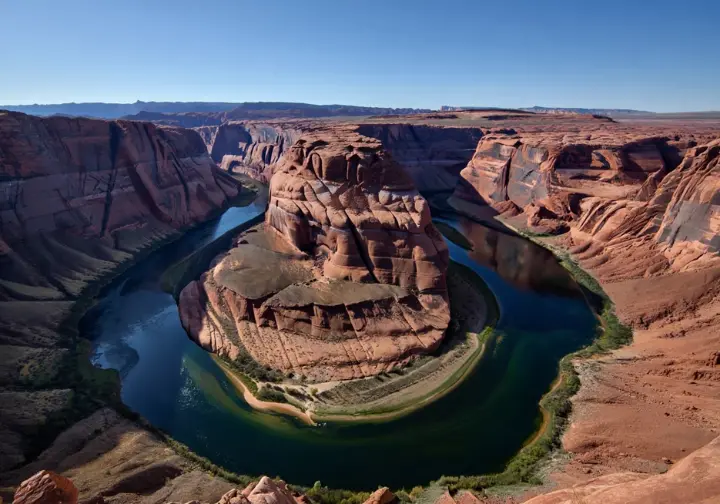
Experience one of the most photographed vistas in the world at Dead Horse Point State Park. Adjacent to Canyonlands, this Utah state park offers accessible trails, camping, biking, and designated dark skies, making it a must-see on any Moab list.
Enjoy Iconic Park Views
Stand atop the dramatic mesa viewpoint, easily reached via a short paved path. Witness the breathtaking 270-degree panorama of the Colorado River making a massive gooseneck bend 2,000 feet below. This iconic view is the park’s main draw, offering a quintessential Moab landscape experience with minimal physical exertion. It’s truly one of the amazing things to witness.
Hike along the mesa rim for continuous canyon vistas. Use the relatively easy East Rim Trail (approx. 2 miles one-way) or the more primitive West Rim Trail (approx. 2.5-3.5 miles one-way). Combining them creates a loop hike of 5-7 miles, offering spectacular perspectives of the surrounding canyon country and the distant La Sal Mountains.
Take advantage of the park’s excellent accessibility. Paved paths lead to main overlooks, and there are accessible restrooms, visitor center access, and even an accessible campsite and yurt. This makes it a great option for visitors with mobility challenges. Braille astronomy materials are also available, showcasing a commitment to inclusivity.
Plan your visit considering the park entrance fee ($20 per vehicle as of research date, valid two days) and operating hours (6 am to 10 pm). The Visitor Center (9 am to 5 pm daily) offers exhibits, information, a gift shop, and the Dark Horse Cafe. Capturing stunning photos is easy here, especially during sunrise and sunset when light illuminates the canyon walls.
Try Biking and Stargazing
Explore the Intrepid Trail System, a 16.6-mile network of purpose-built singletrack mountain bike trails. It offers loops for various skill levels, from flowy beginner/intermediate routes like Intrepid and Great Pyramid to more challenging Big Chief loops. These trails provide fantastic riding with incredible canyon backdrop views, a truly unique mountain biking experience.
Utilize the park’s designation as an International Dark Sky Park for exceptional stargazing. The high elevation and lack of light pollution create perfect conditions. Attend ranger-led astronomy programs, often including telescope viewings and full moon hikes, for an educational nighttime experience. Have you ever seen the Milky Way stretch across a desert sky?
Traveling with pets? Dogs are permitted on leash on hiking trails and in campgrounds but not on the Intrepid Trail System mountain bike trails. Plan accordingly if you intend to bike. Consider camping within the park at the Kayenta or Wingate campgrounds (reservations highly recommended) or rent a unique yurt for a glamping experience. Campsites offer hookups, but RVs need water beforehand.
Good news for some riders: Class 1 e-bikes are permitted on the Intrepid Trail System. This expands access for those who benefit from pedal assistance while enjoying the scenic singletrack. It’s easy to combine activities here: a morning hike, afternoon bike ride, sunset views, and then stargazing make for a fulfilling trip.
Ride World-Class Trails
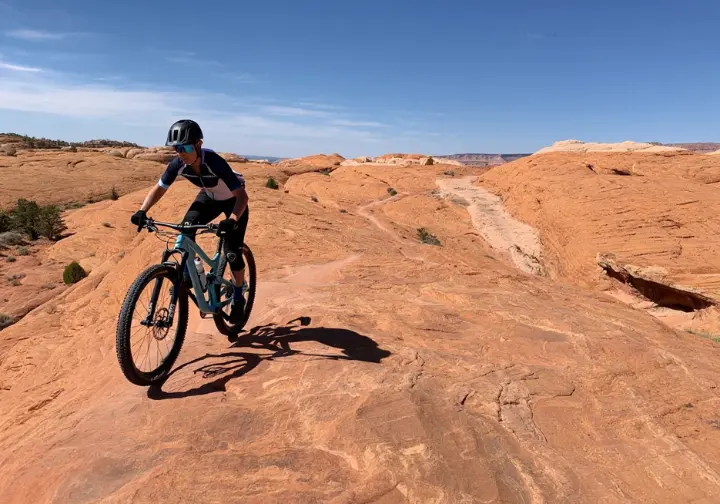
Moab is legendary as a global mountain biking destination. It offers an unparalleled variety of trails, from beginner-friendly paths winding through desert scrub to technically demanding slickrock adventures that test the most seasoned riders. Finding the right trail is key among the things to do moab.
Bike Famous Slickrock Trail
Test your skills on the iconic Slickrock Bike Trail within the Sand Flats Recreation Area. This challenging 10.6-mile loop is renowned for its unique surface entirely on undulating Navajo sandstone. While the rock offers excellent grip when dry, the trail is advanced due to extremely steep climbs, descents, exposure near cliffs, and significant aerobic demands. It’s a true Moab proving ground.
Access requires the Sand Flats Recreation Area entrance fee ($10/vehicle or $5/bike for 7-day pass as of research date). This fee covers Slickrock and other area attractions like the Fins & Things off-road trail, supporting maintenance in this popular multi-use sand flats area. Consider guided tours if unsure about navigation or technical demands; guides provide instruction and support.
Be prepared for the physical challenge and exposure. Carry ample water, wear appropriate safety gear (bike helmets are mandatory), and watch the weather. The slickrock offers little shade and gets incredibly hot in summer. Starting early is crucial. A common mistake is underestimating the heat and hydration needs on this exposed trail.
Navigate carefully using the painted white dashes marking the route across the vast sandstone. Deviating can lead to disorientation or dangerous terrain. A shorter practice loop near the trailhead lets riders gauge the unique riding style before committing to the full loop. It helps build confidence before tackling the main adventure.
Explore Diverse Trail Systems
Discover beginner and intermediate-friendly singletrack at the Moab Brand Trail (Bar-M) system north of town. It’s easily accessible via the paved Moab Canyon Pathway. This network includes introductory loops like Lazy/EZ, ideal for families or novice mountain bikers. Trails like North 40 offer progression challenges for those building skills.
Ride the scenic Intrepid Trail System within Dead Horse Point State Park. Its 16.6 miles of flowing singletrack offer stunning canyon views suitable for easy to intermediate riders, plus some moderate technical sections. Access requires the state park fee, and Class 1 e-bikes are permitted, making it another excellent choice for progressing riders.
Explore the Klondike Bluffs area, another large trail system north of Moab. It offers a diverse mix of beginner, intermediate, and some advanced trails like Dino-Flow. This area is also known for access to nearby dinosaur track sites, adding a unique element to a biking adventure. It’s one of the many moab ut things to do.
For advanced riders, challenge yourselves on demanding trails near Kane Creek Road, like the Captain Ahab downhill singletrack in the Amasa Back area. The Mag 7 trail network offers a long descent often done via shuttle, ending near the Colorado River. Be aware the optional Portal Trail exit is extremely exposed, suitable only for experts.
Plan logistics using Moab‘s reputable bike shops like Moab Cyclery for rentals (including e-bikes), bike repairs, gear, and crucial local trail advice. Utilize shuttle services like go-to bike shuttl or guided tours for point-to-point rides. Always verify current e-bike rules for specific trails, as regulations vary. Choose your season wisely, favoring spring and fall for pleasant temperatures.
Raft the Colorado River
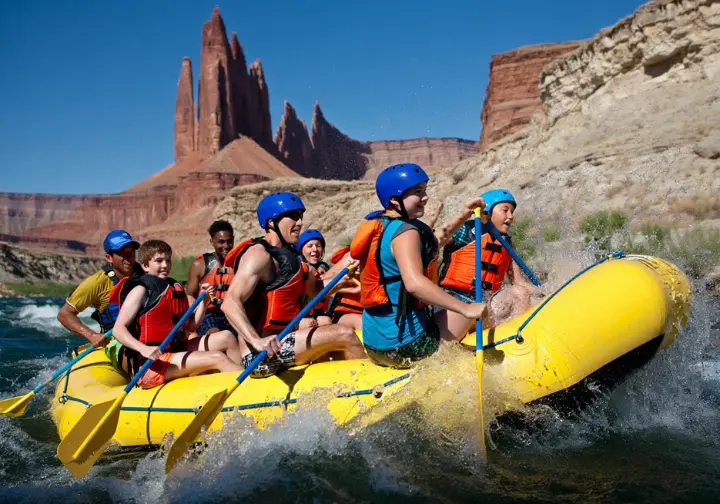
Experience the legendary Colorado River, a defining feature of the Moab landscape. Options range from family-friendly scenic floats past towering red rock formations to thrilling whitewater adventures in remote canyons. Getting on a boat here is a classic Moab thing to do.
Float the Moab Daily
Embark on the most popular rafting day trip, the “Moab Daily.” This scenic stretch flows past the iconic Fisher Towers, featuring mild to moderate Class II-III rapids suitable for families and first-time rafters. It’s a perfect introduction to Moab’s river landscape without extreme whitewater, offering great scenic views from the water level.
Choose convenient half-day (approx. 7 miles) or full-day (approx. 13-14 miles, often includes lunch) guided rafting trips offered by nearly all Moab outfitters like the Moab Adventure Centr. Costs are relatively affordable, making it an accessible adventure. We once took a family down who were nervous, but the gentle rapids and guide’s calm demeanor turned them into river lovers by the end!
Consider an overnight trip (2 days/1 night) on the Moab Daily section for a more immersive experience. This includes riverside camping under the stars, meals prepared by guides, and extended time enjoying the canyon scenery. It offers a taste of multi-day rafting without committing to longer expeditions.
Verify minimum age and weight requirements with your chosen outfitter (typically around 4-7 years old and 40-50 lbs minimum). Outfitters provide necessary safety gear like PFDs (life jackets). A common mistake is forgetting secure footwear; bring river sandals or water shoes that won’t come off in the water. Sun protection (hats, sunglasses, sunscreen) is essential due to strong reflection off the water. Wearing the right gear makes a huge difference.
Try Kayaks and SUPs
Opt for a more personal adventure by paddling your own inflatable kayak (single or tandem “ducky”) through the Moab Daily rapids alongside a guided raft trip. Outfitters provide instruction and support, letting you navigate the waves yourself for added thrill (minimum age typically higher, e.g., 10+). It’s a step up in engagement.
Explore calmer stretches upstream (like Meander Canyon) or the placid Green River (like Labyrinth Canyon) via traditional kayaks or stand-up paddleboards (SUPs). Rentals and guided flatwater tours are readily available from outfitters like Paddle Moab for serene paddling amidst stunning canyon scenery. It’s a different way to connect with the desert waterways.
Rent kayaks or SUPs for use on Ken’s Lake, a reservoir south of Moab. It offers a sheltered flatwater environment perfect for practicing skills or enjoying a relaxed paddle away from the river current. This is an excellent option for families or beginners wanting to try paddling independently before tackling the Colorado River.
Consider unique combination tours pairing canyoneering with a relaxing SUP float afterwards. These “surf and turf” experiences showcase the multi-sport possibilities available in the Moab area in a single day. Booking guided trips or rentals in advance is wise, especially during peak spring and fall seasons, as popular tours and equipment sell out.
Go Moab Off-Roading
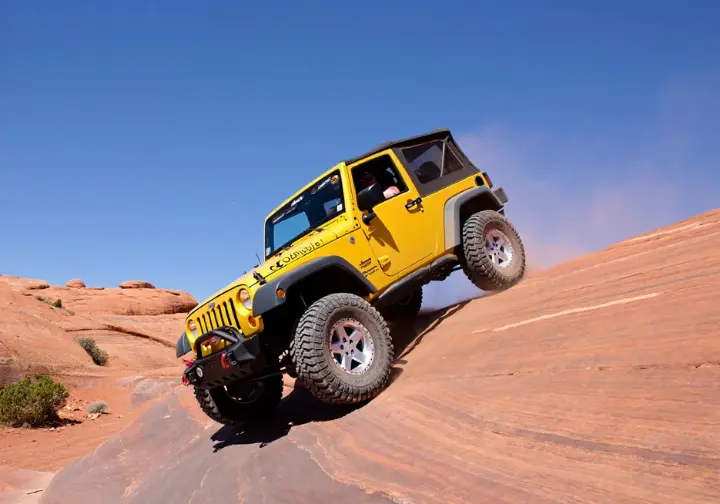
Delve into Moab‘s world-renowned off-roading scene. Navigate iconic slickrock trails via guided tours or rentals for an adrenaline-pumping adventure. This is one of the key things to do at Moab Utah, attracting enthusiasts from around the globe.
Conquer Hells Revenge Trail
Experience Moab‘s most famous off-road trail, Hell’s Revenge, conveniently located in the Sand Flats Recreation Area. It’s known for thrilling climbs and descents on steep, petrified sand dunes (slickrock). This trail offers incredible views towards Arches and the Colorado River but is difficult and hazardous. It’s primarily recommended for guided tours or highly experienced drivers in capable vehicles.
Choose a popular guided “U-Drive” UTV/SXS tour. You drive your own rented vehicle while following a professional guide who provides instruction, navigates the challenging route, and assists with obstacles. This format offers the thrill of driving combined with expert safety (driver age requirements apply, typically 16 or 18+). It’s one of the most popular Jeep rides in Moab Utah.
Alternatively, ride as a passenger on a guided Hummer tour. Expert drivers navigate highly capable vehicles over extreme obstacles like Hell’s Gate, providing thrills without driving stress. Sunset tours on Hell’s Revenge are particularly popular, offering dramatic lighting on the red rock. Have you ever witnessed a sunset paint the slickrock gold?
Pay the required Sand Flats Recreation Area entrance fee ($10/vehicle or $5/bike for 7-day pass) to access the Hell’s Revenge trailhead. This multi-use area also hosts the Slickrock Bike Trail, requiring caution where trails intersect. Look for visible dinosaur tracks along the route – guides often point out these ancient footprints preserved in the sandstone. Booking tours well in advance, especially during peak season and holidays like Easter Jeep Safari, is essential.
Explore Other 4×4 Routes
Try the Fins & Things trail, also in Sand Flats Recreation Area. It offers an intermediate challenge with steep climbs and descents over sandstone “fins,” providing a different style of slickrock driving often combined with Hell’s Revenge on longer tours. Access requires the Sand Flats entrance fee.
For experienced drivers seeking a longer, remote, and technically demanding adventure, consider the Poison Spider Mesa trail west of Moab (rated difficult). It features varied terrain, ledges, and impressive overlooks. Guided tours on this route are typically longer (4+ hours). Proper preparation and vehicle capability are crucial here.
Enjoy easier scenic driving suitable for stock 4WD or high-clearance 2WD on routes like parts of Potash Road (Hwy 279) or Kane Creek Road. These offer beautiful canyon scenery and access points without extreme technical challenges. Gemini Bridges Trail is a popular intermediate route. These are great options for seeing the landscape without the intense obstacles.
Consider guided scenic 4WD tours focusing less on extreme obstacles and more on landscape exploration. Visit petroglyph panels, dinosaur track sites, and viewpoints like Hurrah Pass. These tours cater to those seeking cultural and scenic immersion. If experienced, consider renting a Jeep or UTV/ATV for self-guided exploration on designated BLM trails, requiring careful planning, maps, and Tread Lightly principles. Always prioritize safety by choosing appropriate trails and informing someone of your plans.
Hike Outside the Parks
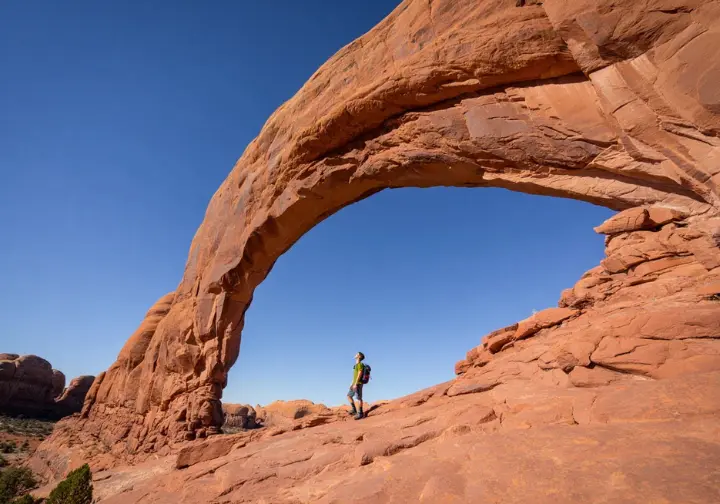
Discover incredible hiking opportunities on public lands surrounding Moab. These trails offer stunning arches, unique towers, streamside canyons, and ancient history, often with fewer crowds than the national parks. Exploring these areas is a rewarding part of the moab ut things to do experience.
Trek to Corona Arch
Hike the popular Corona Arch Trail, a 3-mile round trip rated moderate. It leads to the impressive, massive freestanding Corona Arch and the adjacent Bowtie Arch. This trail provides a rewarding arch viewing experience outside the national parks, a great alternative if you don’t have an Arches entry pass.
Be prepared for varied terrain: slickrock sections, sandy washes, a short sturdy ladder climb, and a cabled section with carved Moki steps. These features add adventure but require careful footing and comfort with mild exposure. Access the trailhead conveniently off Potash Road (Highway 279) west of Moab along the Colorado River. The parking lot can fill quickly, especially for sunset, so arrive early or visit on weekdays.
Combine the hike with nearby attractions along Potash Road. View roadside petroglyph panels, spot dinosaur tracks, or watch rock climbers on “Wall Street.” This allows for an efficient multi-activity outing. Remember sufficient water, sturdy shoes, and sun protection, as the trail offers limited shade across open desert terrain. Proper preparation ensures a safe hike.
See Fisher Towers Area
Hike the Fisher Towers Trail, a 4.4-mile round trip rated moderate. It winds beneath dramatic, uniquely shaped pinnacles of dark red Cutler sandstone. This trail offers otherworldly scenery reminiscent of movie backdrops (several films were shot here) and provides a distinct geological contrast to the lighter sandstone found elsewhere in Moab.
Access the trailhead via a well-maintained dirt road off Highway 128 (the Upper Colorado River Scenic Byway) east of Moab. The drive itself through Castle Valley towards the towers is exceptionally scenic. Navigate trail features including moderate ups and downs, some exposure along ledges, and a short steel ladder near the end viewpoint. These require comfort with such obstacles.
Reach the trail’s end viewpoint overlooking Onion Creek and the surrounding Castle Valley region for a rewarding payoff with expansive vistas. Allow ample time (2-3 hours) and carry plenty of water and sun protection due to minimal shade. The unique beauty and relative solitude make Fisher Towers a worthwhile destination for hikers seeking dramatic desert scenery.
Walk Grandstaff Canyon Trail
Enjoy a refreshing hike along the Grandstaff Canyon Trail (formerly Negro Bill Canyon), a 5.7-mile round trip rated moderate. It follows a perennial stream through a lush, beautiful canyon just miles from Moab on Highway 128. The water and shade make it popular, especially during warmer months. It’s a welcome oasis in the desert.
Be prepared for numerous shallow stream crossings (8-10 each way). Water-friendly footwear like secure sandals or waterproof hiking shoes is necessary. These crossings are part of the fun but require appropriate gear. A common mistake here is wearing inadequate footwear, leading to discomfort or slips.
Hike to the trail’s end destination: the impressive Morning Glory Natural Bridge. Spanning 243 feet, it’s the sixth-longest natural rock span in the US. The area around the bridge offers a cool spot to rest. Exercise caution and stay on the main trail to avoid patches of poison ivy common near the stream. Recognizing the plant is important.
Take advantage of the trail’s dog-friendly policy (on leash), unlike trails within nearby national parks. Remember to pack out all waste. Note that this canyon is also an exit route for technical canyoneering trips, so you might see groups with ropes near the bridge. Respect their space.
Discover Unique Moab History
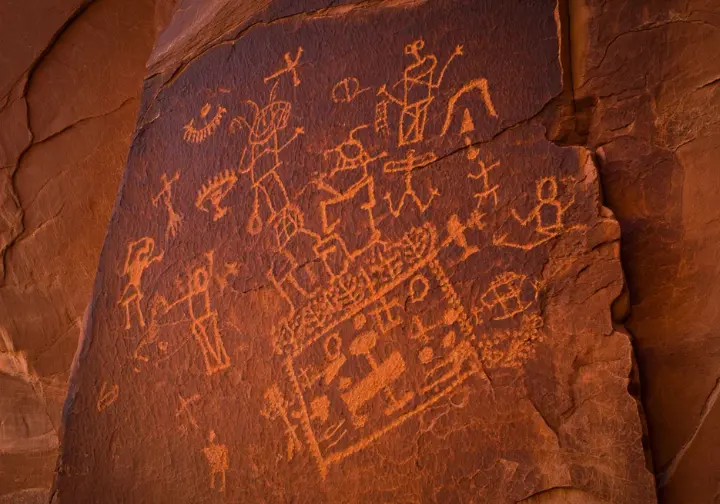
Explore Moab‘s rich past and quirky present. Seek out ancient rock art, fossilized dinosaur tracks, unique geological sites, and engage with local culture beyond the main adventure hubs. Understanding this history adds another layer to the Moab, Utah experience.
Find Petroglyphs Pictographs
Discover ancient rock art panels created by various cultures (Archaic, Ancestral Puebloan, Fremont, Ute). Etched and painted onto sandstone cliffs throughout the Moab area, they offer tangible connections to the region’s long human history. Many significant sites are surprisingly accessible, requiring minimal hiking.
Drive along Potash Road (Highway 279) west of Moab. Stop at designated pullouts about 5 miles from Highway 191 to view large, easily visible petroglyph panels right next to the road. This is one of the most convenient ways to see impressive rock art. It’s fascinating to ponder the stories these markings tell.
Visit the Golf Course Rock Art site near the Moab Golf Course (short walk) to see the unique “Moab Man” figure. Explore panels along Kane Creek Boulevard near Moonflower Canyon campground and the distinct “Birthing Rock” boulder further down the road. Hike the short, flat 0.5-mile trail into Courthouse Wash (near Arches entrance) to see large pictographs (painted figures) and petroglyphs.
Always view rock art responsibly. Never touch, trace, chalk, wet, or make rubbings. Oils from hands cause irreparable damage. Observe from a respectful distance and leave no trace. Consider visiting Newspaper Rock State Historical Monument south of Moab (en route to Needles) for a vast collection on one rock face.
Hunt for Dinosaur Tracks
Explore Moab‘s rich paleontological past by visiting sites with fossilized dinosaur tracks from the Mesozoic Era. Several sites are easily accessible and provide interpretive information, offering a glimpse into when giant creatures roamed this land. It adds a prehistoric thrill to moab things to do.
Visit the Mill Canyon Dinosaur Tracksite north of Moab. An accessible interpretive boardwalk covers an area with over 200 tracks from various dinosaurs. The nearby Mill Canyon Dinosaur Bone Trail allows viewing of fossilized bones still embedded in the rock. It’s a fascinating window into deep time.
Hike a short but steep 200-yard trail/scramble from the Poison Spider Trailhead area off Potash Road. See numerous well-preserved dinosaur tracks on large, tilted sandstone slabs at the Poison Spider Dinosaur Tracksite. Petroglyph panels are also nearby, combining paleontological and archaeological interest.
Discover other track sites like Bull Canyon Overlook (longer drive, short trail), Copper Ridge (short uphill hike north of Moab), and Willow Springs (near Klondike Bluffs bike trails). Tracks are even visible along the popular Hell’s Revenge 4×4 trail. Enhance your discovery by visiting Moab Giants Dinosaur Park north of town or the Moab Museum downtown, which covers regional paleontology and human history. Treat these fossil sites with care, staying on designated paths and avoiding touching the tracks.
See Quirky Atlas Obscura Sites
Seek out unusual and offbeat attractions highlighted by sources like Atlas Obscura for a unique perspective on the Moab area. These sites often reveal quirky history, industrial curiosities, or unique geological formations beyond traditional parks and trails. Finding these hidden gems adds another layer to your adventure.
View the surreal, bright blue Potash Evaporation Ponds west of Moab along Potash Road (Highway 279). Solar evaporation used in potash mining creates a stark industrial landscape against the red rocks. These ponds are visible from the road or distant viewpoints like Dead Horse Point State Park.
Visit Hole N” the Rock south of Moab on Highway 191. This unique roadside attraction features a 5,000-square-foot home carved directly into a massive sandstone cliff, complete with a trading post and zoo. Tours of the home offer a glimpse into mid-century desert ingenuity and kitsch.
Explore Tusher Tunnel, a natural passage eroded through a sandstone fin north of Moab, large enough to walk through. Accessing this site typically requires driving on rough dirt roads, likely needing high-clearance or 4WD vehicles. Discover Gemini Bridges, a pair of large natural sandstone bridges north of Moab off Highway 313, accessed via the Gemini Bridges 4WD/bike trail. Intrepid visitors can carefully walk across (use extreme caution). Stop by the historic Moab Rock Shop on Main Street Moab, founded in 1960, functioning as both a shop and small museum.
Plan Your Moab Adventure
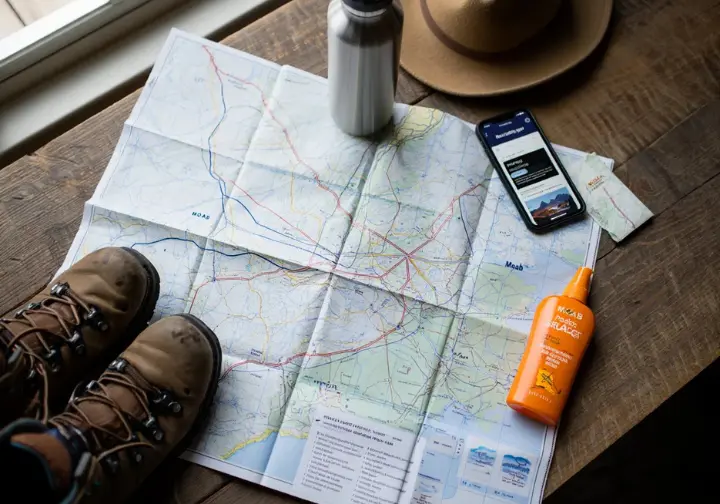
Navigate the essential logistics for a successful Moab trip. This includes timing your visit, understanding permits, getting around, and finding resources to maximize your experience beyond Arches. Proper planning is the first step towards enjoying all the things to do moab utah.
Know Best Times Visit
Aim for the shoulder seasons of spring (March-May) and fall (September-October) for the most pleasant weather. Moderate temperatures are ideal for hiking, biking, and other outdoor activities. However, these are also the busiest times, meaning significant crowds and higher lodging costs. What’s your tolerance for crowds versus ideal weather?
Prepare for extreme heat if visiting during summer (June-August), with temperatures often exceeding 100°F (38°C). Midday activity becomes strenuous. Plan activities for early morning or late evening, stay extremely well-hydrated, seek shade, and consider water-based activities like river rafting or escaping to the cooler La Sal Mountains.
Consider a winter visit (December-February) for the fewest crowds and lowest accommodation prices. It offers a peaceful desert experience. Be prepared for cold temperatures, shorter daylight hours, and potential snow/ice impacting higher elevation roads and some trails. Some find the quiet solitude of winter Moab truly special.
Be particularly aware of peak crowding during major holidays (Easter week/Jeep Safari, Memorial Day, Labor Day) and the Utah Education Association (UEA) break in mid-October. Lodging and tour availability is scarce, prices peak, and popular areas become congested. Advance booking is absolutely essential during these periods. To mitigate crowds during peak season, visit popular spots very early or late, choose weekdays, explore lesser-known trails, and use the Moab Information Center for current conditions.
Secure Permits Reservations
Understand that accessing Arches National Park during peak season (typically April-October) requires a timed entry reservation obtained in advance through Recreation.gov, plus the park entrance fee. These reservations manage visitor flow and sell out quickly, especially morning slots. Planning ahead prevents disappointment at the gate.
Recognize that permits are required for many popular activities within Canyonlands National Park. This includes all overnight backcountry use (hiking, 4WD camping) and day-use vehicle or bike travel on specific roads like the White Rim Road and 4WD routes in the Needles. These permits are often highly competitive and must be secured months ahead.
Book popular commercial tours (like rafting the Moab Daily, Hell’s Revenge UTV tours, guided canyoneering) well in advance, especially during peak season or holidays. Trips frequently sell out. Contact outfitters like the Moab Adventure Centr directly or use booking platforms. Don’t wait until the last minute for these high-demand activities.
Reserve campsites far in advance, particularly within national parks (Arches, Needles Campground), Dead Horse Point State Park (campgrounds/yurts), and popular private campgrounds in Moab. First-come, first-served sites fill extremely early during busy periods. Secure lodging (hotels, rentals) months ahead for peak season travel, as availability dwindles and prices rise. Stay organized by creating a Recreation.gov account, noting reservation opening dates, and having backup plans. Flexibility and diligent planning are crucial.
Conclusion: Moab Beyond Arches
So, while the allure of Arches is strong, Moab, Utah, offers an extraordinary wealth of diverse adventures that extend far beyond its most famous park. World-class mountain biking, Colorado River rafting, thrilling off-roading, stunning hikes, and unique cultural sites await exploration.
Exploring beyond Arches allows discovery of Canyonlands National Park’s vastness, Dead Horse Point State Park‘s iconic views, and countless trails on surrounding public lands, often with fewer crowds. This broader perspective reveals the true depth of things to do moab.
To make the most of it, plan your trip well in advance, especially during peak seasons. Research and secure necessary permits (like for Canyonlands 4WD roads), timed entry reservations (Arches), lodging, campsites, and popular tours. Utilize authoritative resources like official park websites and DiscoverMoab.com for accurate information.
Identify your primary interests and fitness level to build a realistic itinerary. Balance adventure with appreciating the unique desert environment. Pack appropriately for the climate, choose activities suited to the season, and always practice Leave No Trace principles to protect Moab‘s fragile landscapes for future visitors.
Frequently Asked Questions
Do I need reservations for everything in Moab? >
What’s the best time to visit Moab to avoid crowds? >
Is Moab only for extreme sports? >
Can I bring my dog to Moab? >
We are a participant in the Amazon Services LLC Associates Program, an affiliate advertising program designed to provide a means for sites to earn advertising fees by advertising and linking to Amazon.com. As an Amazon Associate I earn from qualifying purchases. We also participate in other affiliate programs. The information provided on this website is provided for entertainment purposes only. We make no representations or warranties of any kind, expressed or implied, about the completeness, accuracy, adequacy, legality, usefulness, reliability, suitability, or availability of the information, or about anything else. Any reliance you place on the information is therefore strictly at your own risk. Additional terms are found in the terms of service.


